Belladonna’s Toxic Twins
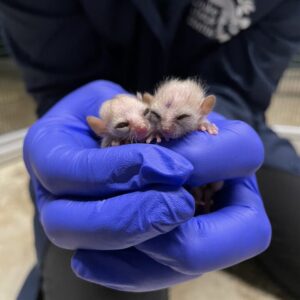
Three-day-old mouse lemur twins Rhubarb (left) and Taro (right) are carefully handled for an infant wellness exam. When gray mouse lemur infants are under a month old, their caretakers will often mark their foreheads with colored dots to tell twins or triplets apart. Photo by Kathryn F.
We’ve had a twin-tastic summer at the Duke Lemur Center! On July 14, 2024, first time gray mouse lemur mom Belladonna gave birth to twin girls: Rhubarb and Taro.
You may remember Belladonna as one member of the “Toxic Trio,” a set of mouse lemur triplets born last summer to mom Fauna who were named after toxic plants. Keeper Kathryn, the primary caretaker for Belladonna and family, wanted to stick to the naming theme, with a unique twist. “I wanted to name them after edible plants because of Belladonna’s tendency to nest them in her food bowls, but I also stuck with Belladonna’s toxic theme,” she said. “Rhubarb has toxic leaves but an edible stem, and taro is toxic unless cooked correctly.”
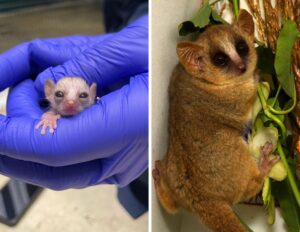
Rhubarb at two days old versus two months old. Photos by Kathryn F. (left) and David Haring (right).
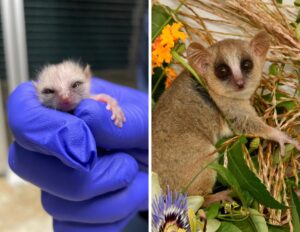
Taro at two days old versus two months old. Photos by Kathryn F. (left) and David Haring (right).
Did you know that Belladonna is the gray mouse lemur representative for our Adopt a Lemur program? You can support Belladonna, Rhubarb, and Taro by symbolically adopting this first-time mom, and you’ll receive quarterly updates with photos and information on the infants’ development. Belladonna’s adopters also got early access to the news about the babies in their August update!
Mushmelon’s Fruity Duo

Lychee and Rambutan are held gently by a veterinarian during their infant wellness exam.
On June 23, 2024, another gray mouse lemur became a first-time mom: Mushmelon! Despite being ten years old, which is quite elderly for a mouse lemur, Mushmelon had a healthy set of twins. Just like their mom, these sweet babies were named after fruits—a female named Lychee, and a male named Rambutan.
Gray mouse lemurs commonly have singletons, twins, and triplets. With adults growing to only about three inches tall and weighing about as much as a stick of butter, mouse lemurs are the smallest species in our colony. The DLC houses one of the only gray mouse lemur breeding colonies in North America, and our mouse lemur population consists of just under 50 individuals.
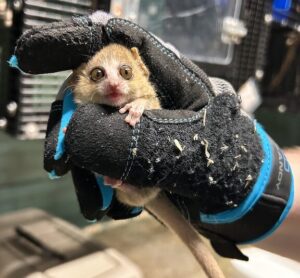
One of the twins at around a month old. Our keepers wear bite-proof gloves when handling lemurs for routine weigh-ins to protect their hands!
Merriweather’s Flower Girls
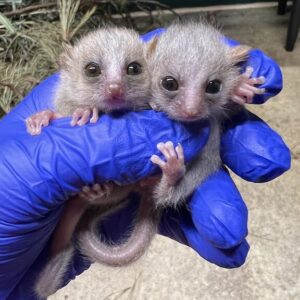
Sisters Beautyberry and Tea Olive during an infant weigh-in around one or two weeks old. Photo by Jodi S.
Unlike many of our other mouse lemur moms this year, Merriweather has plenty of experience with infants. This six-year-old female successfully raised triplets in 2021, and she has returned to motherhood this summer with twin girls. On August 8, 2024, she gave birth to Beautyberry and Tea Olive, the final two infants of our 2024 baby season. Beautyberry shares her name with a flowering shrub that sports gorgeous magenta berries in the fall, while Tea Olive is named after a flowering tree that has been compared in fragrance to jasmine and gardenia.
Congrats to all of our lemur moms on a successful baby season!
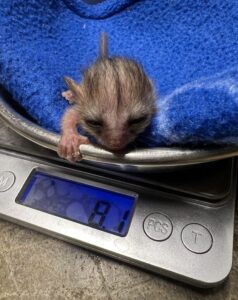
During their three-day-old infant wellness exam, one of Merriweather’s daughters weighed 8.1 grams—about the weight of a wedding ring. Photo by Jodi S.
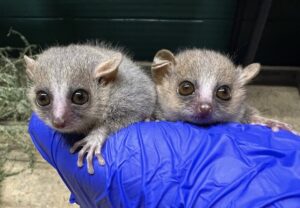
Because they only live three to five years in the wild, mouse lemurs grow up quickly. Look how big Beautyberry and Tea Olive grew in just a few weeks! Photo by Jodi S.

